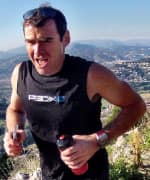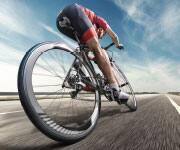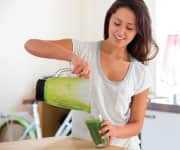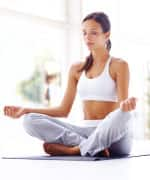Life Extension Magazine®
“My life’s work is helping people exercise the right way for their bodies while inspiring them to accomplish feats they never dreamed possible,” says yoga teacher and personal trainer Ted McDonald.
“We have the power to enhance our health as we mature. The key to unlocking this involves following a realistic exercise plan and scheduling extra time to rest. Taking time to regenerate your body and mind is as vital a part of a mature lifestyle as exercise.”
McDonald also aims to help people of all ages repel aging through a combination of healthy diet and smart supplementation.

McDonald, age 45, is a globe-trotting yoga teacher and personal trainer to Tour de France cyclists, Olympic medalists, post-pregnancy mothers and mature adults who are late to the exercise game. He is also a triathlete, marathon runner and owner of 5 Point Yoga, the premier yoga and fitness studio in Malibu, Calif. A former ULCA lacrosse player, McDonald’s positive-aging exercise programs for men and women are informed by evidence-based medical research. As founder of Yoga Adventures (adventureyogaretreats.com) Ted also leads people on adventure yoga and fitness vacations around the US and to countries such as Peru and Ethiopia.
This writer caught up with McDonald one afternoon while he babysat his infant daughter, Madison, his first child with wife Lauren Lobley. (A health coach, vegan chef and blogger, Lobley dispenses a treasure trove of healthy recipes, evidence-based mind/body research and information on her website, delectableyou.com)
While he has been teaching yoga since 2000, McDonald became hooked on mind/body discipline because it helped him prepare for and recover from marathons, triathlons and 24-hour adventure racing.
“24-hour adventure racing is a multisport event that includes mountain biking, kayaking, trekking and navigation across land and sea,” McDonald says. He competed for four years on a team of men and women called the Zen Warriors.
“I raced on PowerBar’s Team Elite,” McDonald recalls. “I served as a navigator because I love plotting courses and guiding a team, despite the added mental exertion.
“A typical race could start off with a 14-mile three-person kayak race, followed by a 20-mile mountain-bike ride, which culminates in a 17-mile trek moving forward via running or hiking. Adventure racing can also involve coasteering, which is like mountaineering only along the seacoast. This means you’re running on the beach or walking as fast as you can over the rocks.”

Although McDonald has given up 24-hour adventure racing, he still competes in marathons and triathlons.
“My longtime yoga practice comes into play whenever I’m racing today,” hesays.
Along with teaching yoga and personally training clients, Ted works as the official yoga teacher for the BMC Tour de France team of cyclists.
“The BMC Tour de France training camp encompasses rigorous cycling practice and other workouts in the mountains of Spain,” McDonald explains.
Every morning at the BMC training camp, McDonald leads the cyclists in a 30-minute “easy yoga flow class that gets their hearts going, promotes blood circulation, loosens them up and gets them focused for the day’s training.” After the morning yoga session, the cyclists ride in the mountains for four to six grueling hours.
“In the early evening,” McDonald says, “the athletes do restorative yoga that helps them recover from the day’s exertions for 45 minutes.
“In the 2016 Tour de France, one of the BMC team members from Belgium, Greg Van Avermaet, won a stage, which means he came in first during one section of the race. I felt so happy for him.”
Following this successful showing, Van Avermaet went to the Rio Olympic Games and won a Gold Medal for a 236-kilometer road race.
“Phenomenal achievements like these remind me how fortunate I am to work with and learn from athletes who are continually developing their performance, endurance and recovery capabilities.”
Speaking of recovery, McDonald diligently combs through peer-reviewed medical journals for exercise physiology and biology research studies on the subject.
“Research published in the June 2016 FASEB Journal (the official journal of the Federation of American Societies for Experimental Biology) suggests that the ability of muscles to repair themselves, though impeded by aging, can be gradually improved by enacting a regular exercise routine,” McDonald says.
“It appears that in older populations, exercise can help promote muscle healing. This is important and especially great news for people 40 and over. Previously, exercise physiologists widely believed that muscle repair from injury consistently declined with age. These latest findings signal that it’s never too late to reap the benefits of an exercise regimen.”
In the study that McDonald is referring to, scientists tracked three groups of mice. One group consisted of young mice that were never exercise-trained, another consisted of old mice that were also never exercise-trained, while the third group was comprised of older mice that had been put through workouts.
The athletic older mice worked out three days per week for eight weeks. Scientists later tested all three groups after giving them a tiny dose of snake venom, which created a physiological condition that simulated the effect of a muscle injury. All the mice were tested 10 days after and then 28 days after they received the snake venom. The group of trained older mice had notably more muscle repaired compared to the two other groups.
Anytime is the right time to go outside for a brisk walk, hike or run.
“If you’re into low-impact activities, you can ride a bike,” McDonald suggests. “When you start to feel the positive physical, mental and emotional benefits of exercise, you will feel too energized to slide back into sedentary living.”
While the major issues that affect members of the Baby Boomer population include declining muscle mass, loss of bone density, reduced cardiovascular fitness and declining aerobic capacity, McDonald observes that high-intensity interval training can be a highly effective strategy for managing these age-associated conditions.
“High-intensity interval training helps Baby Boomers condition and strengthen their bodies very effectively in a relatively short period of time,” he says. “This is because it demands that the body function at high aerobic intensity while also forcing muscles and bones to work at their upper limits.”
McDonald believes the exertions involved in high intensity interval training can help counteract the effects of aging.
“Once you pass the age of 40, you still have to push yourself just as much as you did when you were in your 20s, if not more, but you need to give yourself extra time to recover from exercise,” he says.
Supplements For Enhanced Endurance
 |
On a weekly basis, depending on the season and whether he’s training for a marathon or a triathlon, Ted takes varying doses of vitamins.
Probiotics, schisandra fruit, maca root, green tea extract, spirulina, calcium and iron are also in the mix, along with reishi mushroom, ashwagandha root, whole plant chlorella, cordyceps mushroom, astragalus root, wolfberry, maitake mushroom, MSM, and rose hips.
Every day between meals, McDonald drinks a vegan, low-glycemic index protein drink.
He also takes an enzyme blend of amylase, cellulase, lactase, glucoamylase, alpha-galactosidase and invertase.
Citing an article about the scientific basis of high-intensity interval training published in the journal Sports Medicine, McDonald notes that plyometrics, also known as “jump training,” is also another highly effective workout for developing speed and strength. Plyometrics involves learning how to move from a muscle extension into a contraction in rapid sequence, such as in specialized, repeated jumping.
“As long as you don’t have arthritis or joint problems, plyometrics can be a great workout.”

While exercise increases release of endorphins, the body’s natural feel-good chemicals, “it also helps promote sounder sleep and initiates a cascade of other beneficial physiological processes that help build strength, balance and confidence,” McDonald notes. “This confidence translates to physical grace and more self-assured body language, which in turn makes it easier for you to move through the world.”
Exercise, however, is just one component of enjoying mental, emotional and physical fitness well into maturity. Another essential tool to adult wellness is blood and cholesterol tests.
“Body biochemistry panels provide essential evidence that will help you maintain the most positive diet and active, mature lifestyle,” McDonald says. “I know this as a result of personal experience.”
When he turned 40, McDonald decided to get blood work done so he knew the facts about his body biochemistry.
He finally got around to it at age 43, and lab results indicated that he was insulin resistant, “literally prediabetic.”
McDonald realized that so much of the so-called “healthy” food he had been eating for years had been causing cumulative damage.
“I ate a lot of high carbohydrate foods such as oatmeal, bananas, sugar-rich protein bars and energy gels that are high in fructose,” he says. “When I started adding up all the carbohydrates that I had been eating, I realized that one energy gel I regularly consumed contained 27 grams of carbohydrate. I had been overstimulating my pancreas for years, which is why I was headed for diabetes.”
After this wake-up call, McDonald totally revamped his diet.
“I cut out energy bars and energy gels and fructose-laden energy drinks, plus I stopped eating fruits except for berries. Because of the carbs in oatmeal, bread, rice and pasta, I also stopped eating these. I stopped eating corn chips and tortillas and reduced my corn consumption to a fraction of what I formerly ate. For healthy protein, healthy fat and energy, I started eating handfuls of nuts, mainly almonds, throughout the day. I also increased my intake of avocados and started eating wild fish twice weekly.”
Three months later, McDonald got retested and his numbers had dropped markedly.
“I am living proof that exercise is no substitute for a bad diet. The upside of my insulin resistance scare is that it helps me explain how this condition can be reversed by eating a low-carb diet. Moreover, checking with one’s doctor to establish a safe exercise regimen, customized supplementation, plus frequent rest and recovery periods rounds out the plan for optimal health.”
Ted McDonald can be reached by email at ted@teddymcdonald.com.
For inspiration and information on health and exercise, read his blog at teddymcdonald.com.
If you have any questions on the scientific content of this article, please call a Life Extension® Wellness Specialist at 1-866-864-3027.

